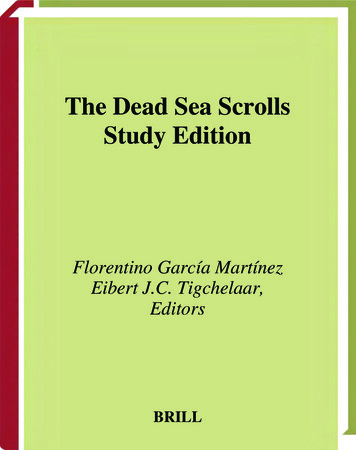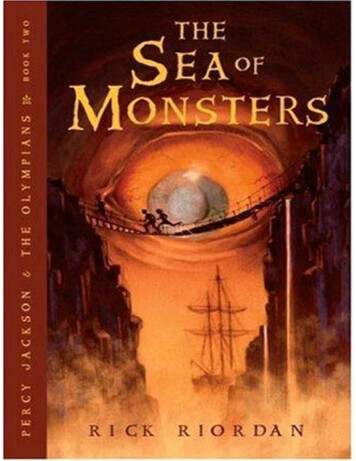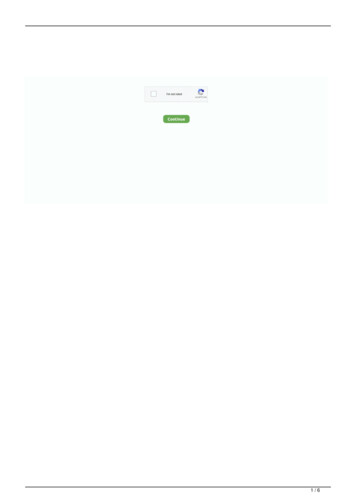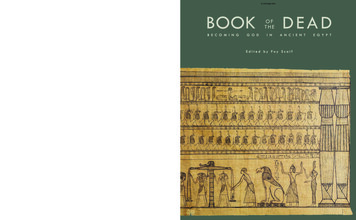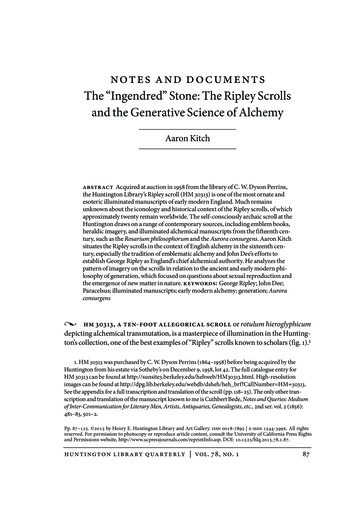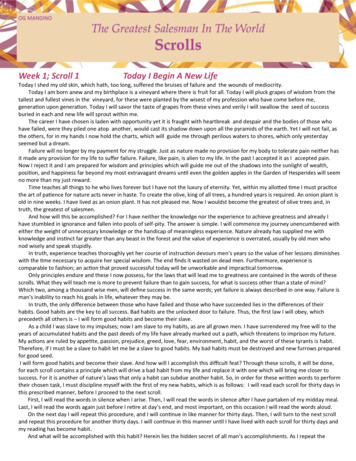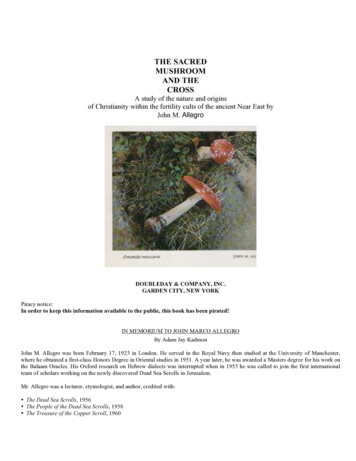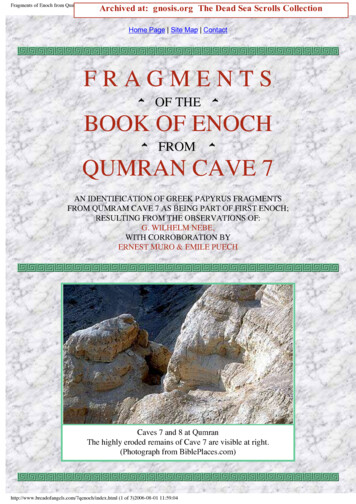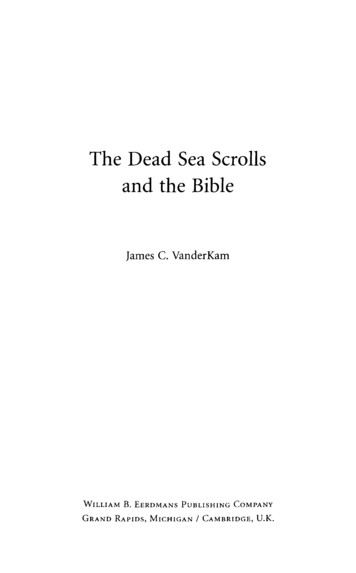
Transcription
The Dead Sea Scrollsand the BibleJames C. VanderKamWILLIAM B. EERDMANS PUBLISHING COMPANYG R A N D RAPIDS, MICHIGAN / CAMBRIDGE, U.K.
2oi2 James C. VanderKamAU rights reservedPublished 2012 byWm. B. Eerdmans Publishing Co.2140 Oak Industrial Drive N.E., Grand Rapids, Michigan 49505 /P.O. Box 163, Cambridge CB3 9PU U.K.Printed in the United States of America18 17 16 15 14 13 127 6 5 4 3 2 1Library of Congress Cataloging-in-Publication DataVanderKam, James C.The Dead Sea scrolls and the Bible / James C. VanderKam.p.cm."Six of the seven chapters in The Dead Sea scrolls and the Biblebegan as the Speaker's Lectures at Oxford University, deliveredduring the first two weeks of May 2009" — Introd.Includes bibliographical references.ISBN 978-0-8028-6679-0 (pbk.: alk. paper)L. Dead Sea scrolls.2. Dead Sea scrolls — Relation to the Old Testament.3. Dead Sea scrolls — Relation to the New Testament.4. Judaism — History — Post-exilic period, 586 B . c - 2 1 0 A . D .BM487.V255I. Title.201222i.4'4 — dc232011029919www.eerdmans.com
ContentsINTRODUCTIONIXABBREVIATIONSXÜι. The "Biblical" Scrolls a n d Their ImplicationsιN u m b e r of Copies from the Q u m r a n Caves2Other Copies4Texts from Other Judean Desert Sites5Nature of the Texts7General Comments7The Textual Picture9An End to Fluidity15Conclusions from the Evidence15New Evidence and the Text-Critical Quest172. C o m m e n t a r y on Older Scripture in the ScrollsOlder Examples of Interpretation2528In the Hebrew Bible28Older Literature Outside the Hebrew Bible30Scriptural Interpretation in the Scrollsν35
Continuous Pesharim36Other Forms of Interpretation38Conclusion473. Authoritative Literature According to the Scrolls49The Importance of Scripture52Was There a Collection of Authoritative Scrollsin the Second Temple Period?55Scriptural Practice60Statements about Groups of Authoritative Works61Statements That Specific Works Were from God andThus Authoritative67Quotations from a Book Introduced with CitationFormulas69A Commentary704. New Copies of Old TextsThe Texts7273Jubilees73Aramaic Levi77The Book of Giants81The Wisdom of Ben Sira (Sirach)85Tobit89Enoch91Epistle of Jeremiah93Psalms 151,154,931555. Groups and G r o u p Controversies in the ScrollsThe Three GroupsEssenes969899Sadducees104Pharisees107
Contents6. The Dead Sea Scrolls a n d the New Testament Gospels118Messiahs120The Works of the Messiah127Scriptural Interpretation130Legal Matters133Rebuking1377. The Dead Sea Scrolls, the Acts of the Apostles,and the Letters of PaulThe Scrolls and Acts 1-4142142Community of Goods143Acts 2, Pentecost, and Sinai147Conclusions155Paul156Scriptural Interpretation1562 Corinthians 6:14-7:1159Works of the Law163BIBLIOGRAPHY167INDEX183
IntroductionSix of the seven chapters in The Dead Sea Scrolls and the Bible began asthe Speaker's Lectures at Oxford University, delivered during the firsttwo weeks of May 2009. For the published form of the lectures, I havechanged the first person address of the speeches to the third person, en tered many m i n o r alterations into the texts, and supported the statementsin the texts with footnotes.I am grateful to John Barton of Oriel College for the invitation to be theSpeaker's Lecturer. In the invitation he suggested that the lectures be de voted to topics in the Dead Sea Scrolls. I took that suggestion in a broadsense — surveying some of the many ways in which the scrolls enlightenone's reading of the Bible, also understood in a broad sense as including theHebrew Bible/Old Testament and the New Testament. In fact, the New Tes tament is an important resource for several of the chapters. This is a posi tion it naturally occupies as a near-contemporary, largely Jewish witness topractices, procedures, beliefs, and debates in the late Second Temple period.The purpose of the lectures themselves and also of their publishedform is to provide up-to-date, accessible overviews of major subjects in thearea of the scrolls and the Bible, especially ones that have interested meover the last several decades. Each of them covers central topics in scrollsresearch and inquires about the significance of the data for material in theBible. In particular, I have attempted to think through the implications ofthe scrolls for their time and in their contexts by asking questions such as:What is the information available, what are the problems connected withit, and what possibilities are raised by it? In approaching the areas coveredin the lectures and now in the chapters of this book, I have drawn upon my
previous work, revised, updated, and added to it, while also drawing uponthe m a n y studies written by colleagues and friends in the busy field ofscrolls research. Given the nature of the book, it is not my purpose to pro vide full bibliographical coverage but rather to make a selection from thenearly innumerable publications in order to furnish the reader with docu mentation and indications where further information may be found.The first chapter, "The 'Biblical' Scrolls and Their Implications," be gins with a survey of the manuscript copies of books that eventually be came part of the Hebrew Bible, citations of those books, and other evi dence for their texts in the Judean Desert finds; but it is more concernedwith providing specific examples from the manuscripts and with explor ing where the newer data lead. Chapter 2, " C o m m e n t a r y on Older Scrip ture in the Scrolls," focuses on a major preoccupation of the authors — ex plaining the meaning of older, authoritative works for their time. Includedare studies of the sources of interpretation — whether in the Hebrew Bibleor other, older works — on which the writers could draw and the ways inwhich they went about handling these m o r e ancient texts. The third chap ter, "Authoritative Literature According to the Scrolls," deals with the as sumptions that drove the scrolls writers and the ways in which they indi cate which ancient texts functioned authoritatively at a time when therewas not, as nearly as one can tell, a canon of scripture in the strict sense ofthe term. In Chapter 3 New Testament information is adduced as helpfulcomparative evidence from roughly the same historical period.The fourth chapter contains an essay that was not delivered as one ofthe Speaker's Lectures. "New Copies of Old Texts" is a study of variousJewish compositions that were known before the scrolls discoveries (madebetween 1947 and 1956) but of which fragmentary copies from the originallanguage texts have turned u p in the caves at Q u m r a n . The works coveredare Jubilees, Aramaic Levi, the Book of the Giants, the Wisdom of Ben Sira,Tobit, Enoch (especially the Greek fragments from cave 7 that may containbits of the Epistle of Enoch), the Epistle of Jeremiah, and Psalms 151,154,and 155. All of these works, apart from Aramaic Levi, have found a place inthe Bibles of various groups — even the Book of the Giants among theManichees — and for that reason can be said to fall under the overall ru bric of The Dead Sea Scrolls and the Bible.In Chapter 5, "Groups and Group Controversies in the Scrolls," I turn tothe question of whether the scrolls deal with the three "sects" that Josephusmentioned — Pharisees, Sadducees, and Essenes — and what they say aboutthem, if they do mention them. The texts plainly, in my opinion, speak of the
first and last of these groups, using specific names for both, while the evi dence is weaker for the presence of Sadducees, though there is evidence for a"Sadducean" approach to law in the scrolls. Once again New Testament pas sages are s u m m o n e d as comparative material.The final two chapters are directed principally at places in the Gospels,Acts, and letters of Paul where the scrolls provide illumination that en riches the reading of those texts. The sixth chapter, "The Dead Sea Scrollsand the New Testament Gospels," examines several pericopes and topics(e.g., messianism, legal matters) that benefit the student of the New Testa ment in understanding p h e n o m e n a in the texts. The last chapter, "TheDead Sea Scrolls, the Acts of the Apostles, and the Letters of Paul," offersanalyses of the first chapters of Acts that exhibit profound parallels withthe scrolls, along with some differences, and a n u m b e r of issues in Paulinestudies (scriptural interpretation, 2 Cor. 6:14-7:1, works of the law) in con nection with material in the scrolls.I wish to thank all in Oxford who made my visit and my wife Mary's stayfor the second week such a memorable and enjoyable one: John Barton, asnoted, who issued the invitation but was prevented by family matters frombeing present as he intended; Paul Joyce of St. Peter's College, who ablystepped in and also hosted us at his college; the Rev. Peter Southwell ofQueen's College, Markus Bockmuehl of Keble College and his wife Celia,Christopher Rowland of Queen's College, and John Day of Lady MargaretHall, all of w h o m served as hosts for meals; Alison Salvesen, Martin Good man, and Fergus Millar, who welcomed me to the Oriental Institute; andGeza Vermes, a longtime fellow devotee of the scrolls. I am also grateful toMrs. Elizabeth Macallister, administrative officer in the Theology Faculty,for making such good plans for our visit, and to Kevin Cathcart and NickKing, S.J., for welcoming us to Campion Hall.In preparing the book I have received assistance from Sara Ferry, whoalso was a helpful and eager font of knowledge about Oxford. As he has sooften, Gene Ulrich has been a generous source of information about the"biblical" scrolls and subjects related to them. My wife Mary has taken thetime to read over the chapters and offer suggestions for improving them.Sarah Schreiber, a doctoral student at the University of Notre Dame, de serves lavish praise for her indispensable, expert help in reading the proofsand preparing the index — all done with the utmost good cheer. Onceagain I am grateful to Eerdmans for publishing my work and for their skillin doing so.JAMES C. V A N D E R K A M
AbbreviationsABABRLAnchor BibleAnchor Bible Reference LibraryAnBibAPOTAnalecta biblicaThe Apocrypha and Pseudepigrapha of the Old Testament, ed.R. H. Charles. 2 vols. Oxford, 1913Biblical ArchaeologistBeiträge zur historischen TheologieBrown Judaic StudiesBiblische NotizenBiblical Resource NTCSCODJDDSDEBibBulletin of the School of Oriental (and African) StudiesBeihefte zur Zeitschrift für die neutestamentlicheWissenschaftCatholic Biblical QuarterlyCatholic Biblical Quarterly Monograph SeriesContinental CommentariesCambridge Greek Testament CommentaryCompanion to the Qumran ScrollsCompendia Rerum Judaicarum ad Novum TestamentumCorpus scriptorum christianorum orientalium, ed. I. B.Chabot et al. Paris, 1903Discoveries in the Judaean DesertDead Sea DiscoveriesEtudes bibliques
yclopedia of the Dead Sea Scrolls, ed. L. H. Schiffman andJ. C. VanderKam. 2 vols. New York, 2000Guides to Apocrypha and PseudepigraphaHarvard Dissertations in ReligionHebrew StudiesHarvard Semitic MonographsHarvard Theological ReviewMonographs of the Hebrew Union CollegeInternational Critical CommentaryIsrael Exploration JournalJournal of Biblical LiteratureJournal of Biblical Literature Monograph SeriesJournal of Jewish StudiesJournal of ReligionJournal for the Study of Judaism SupplementJournal for the Study of the Old Testament: Supplement Se riesJournal for the Study of the PseudepigraphaJournal for the Study of the Pseudepigrapha: Supplement Se riesJournal of Semitic Studies SupplementLoeb Classical LibraryLectio divinaLibrary of Hebrew Bible/Old Testament StudiesLibrary of Second Temple StudiesNew International Commentary on the New TestamentSupplements to Novum TestamentumNew Revised Standard VersionNovum Testamentum et Orbis AntiquusNew Testament StudiesOld Testament LibraryProceedings of the American Academy of Jewish ResearchRevue bibliqueRevue de QumranSociety of Biblical Literature Early Judaism and Its LiteratureSociety of Biblical Literature Monograph SeriesSociety of Biblical Literature Septuagint and Cognate StudiesSociety of Biblical Literature Texts and TranslationsStudies in Biblical TheologyXlll
SDSSRLSNTSMSSTDJStPBSVTPTDNTTextTSAJVTVTSupStudies in the Dead Sea Scrolls and Related LiteratureSociety for New Testament Studies Monograph SeriesStudies on the Texts of the Desert of JudahStudia post-biblicaStudia in Veteris Testamenti pseudepigraphicaTheological Dictionary of the New Testament, ed. G. Kittel andG. Friedrich. 10 vols. Grand Rapids, 1964-1976TextusTexte und Studien zum antiken JudentumVetus TestamentumSupplements to Vetus Testamentum
CHAPTER 1The "Biblical" Scrolls and Their ImplicationsFor many the first response to the question about the value of the DeadSea Scrolls to m o d e r n biblical studies would be the copies of scripturalworks found a m o n g them. The fact that many copies of books that laterbecame part of the Hebrew Bible are represented a m o n g the fragments re moved from the caves at Q u m r a n has been trumpeted about as their great est contribution to contemporary analysis and appreciation of the Bible.There have been n u m e r o u s surveys of the scrolls finds that have been la beled "biblical," and the present chapter adds to that survey — but justbriefly. It is worth covering the entire corpus if only because the situationhas continued to change slightly right u p to the present. More space will bedevoted to examining the implications of these unquestionably significantfinds.It is a fact that, among the more than 900 manuscripts identified byeditors of the scrolls, approximately 200-210 qualify as copies of one ormore scriptural books (although the status of the books in question is notalways clear) — that is, copies of works which at some, apparently latertime became parts of the Hebrew Bible. If one adds those discovered atother Judean Desert sites, the n u m b e r jumps to approximately 230. Thehistorical period in which the scrolls from the Q u m r a n caves were tran scribed begins in the third century B.C.E. and continues to the first centuryC E . , with most of them having been copied in the first century B.C.E. or11. The remains of these copies have been gathered by Eugene Ulrich into a singlevolume: The BiblicalLeiden: Brill, 2010).Qumran Scrolls: Transcriptionsand Textual Variants ( V T S u p 134;
2the first C . E . They come from a time many centuries before the earliestrepresentative of the Masoretic Text ( MT, ca. 900 C E . ) and the most an cient codex of the Old Greek translation ( LXX, 4th century C . E . ) . It islikely that the Q u m r a n copies reflect the situation with respect to the textof scriptural books not only at the small site of Q u m r a n but also through out the land of Israel, as some of the scrolls — certainly the earliest ones —were brought to Q u m r a n from elsewhere.NUMBEROF COPIES FROM THE QUMRANCAVESOnly one of the many scriptural scrolls can be called complete, apart froma few scraps: iQIsa contains the entire b o o k of Isaiah. All of the other rep resentatives of "biblical" books are fragmentary to one degree or another,usually to a very high degree. Except for one, every book in the Hebrew Bi ble is represented by at least one fragment a m o n g the Dead Sea Scrolls; themissing one is, of course, the book of Esther. Until recently one always hadto add that there was n o copy of Nehemiah either and to note that there isan absence of evidence from Q u m r a n that Nehemiah was considered oneb o o k with Ezra, as it was later; in fact, there is practically no indication ofthe presence of either book at Q u m r a n , whether of the text or influencefrom it. A fragment with the text of Neh 3:14-15 has turned up, although itremains unpublished (possibly more than one fragment of the manuscripthas survived). Some of the other books in the Hebrew Bible, it must be ad mitted, just barely make the list: a part of the text of Habakkuk, for in stance, may appear on one small fragment (4QXII frg. 102) where the edi tor, Russell Fuller, readsΓ Π Φ [. He identifies the two words ascoming from "Hab 2:4?" (the first three letters and the last are adorneda3812. See B . Webster, "Chronological Index of the Texts from the Judaean Desert," inΕ. Τον, ed., The Texts from the JudaeanDesert: Indices and an Introductionto the Discov eries in the Judaean Desert Series ( D J D 39; Oxford: Clarendon, 2002), 351-446. He in cludes fourteen "biblical" scrolls in the Archaic period (250-150 B . C . E . ) , places 23 in theLate Herodian period (30-68 C . E . ) , and two in the "Late to Post-Herodian period (4Q2,4Q21)(see pp. 3 7 1 , 375, for e x a m p l e ) . All of the earliest scriptural copies are ofapentateuchal books, other than 4 Q J e r .3. 4QEzra (4Q117) consists of three fragments preserving bits and pieces of Ezra4:2-6, 9 - 1 1 ; 5:17-6:5 (see E. Ulrich. "4QEzra," in Ulrich et al., eds., QumranPsalms to ChroniclesCave 4: XI,[ D J D 16; Oxford: Clarendon, 2 0 0 0 ] , 291-93 and pi. 38). In an oddlyanachronistic move, the text is labeled "4QEzra ( E z r a - N e h e m i a h ) " in the list ofQ u m r a n mss. in D J D 39 (p. 48).
with supralinear circlets indicating a high degree of uncertainty in readingt h e m ) . Some others, like Chronicles, do not fare m u c h better: 4QChr(4Q118) consists of one fragment with letters from two columns, with thetext of the first column being unidentified and the second offering a fewletters from four verses in 2 Chronicles (2 Chr 28:27-29:3).Almost all the copies are inscribed in various styles of the square (orAssyrian) script, but twelve manuscripts were written in paleo-Hebrew(with three unidentified ones — 4Q124-125; 11Q22) and at least five inGreek. The list below gives the n u m b e r s of identified copies for each bookof the Hebrew Bible. The numbers in the list may not be exact, since thereare at times problems in determining whether a fragment belongs to a par ticular manuscript or whether one is dealing with pieces from what wasonce an entire book, but they should be nearly correct. The totals repre sented as "19-20" or "8-9" copies for a book indicate some uncertaintyabout whether a few fragments come from one or two copies; the numbersin parentheses express the actual n u m b e r of scrolls involved, in caseswhere more than one book was copied on a single scroll (they are countedonce for each book, thus the larger totals for some b o o k s ) Judges1-2 Samuel1-2 KingsIsaiahJeremiahEzekiel19-2017 (15)13 (12)7(5)3023432166Minor tationsDanielEzraNehemiah1-2 Chronicles4. R. E. Fuller, " T h e Twelve," in E. Ulrich et al., eds., QumranProphets8-9364244248111Cave 4: X,The( D J D 15; Oxford: Clarendon, 1997), 316.5. See J. Trebolle Barrera, "4QChr," in E. Ulrich et al., eds., D J D 16:295-97.6. Ε . Τον writes: "Although most of the scrolls contain only one biblical book, 5Torah scrolls contain two consecutive books. . . . Likewise, the individual books of theM i n o r Prophets were considered as one b o o k contained in one scroll"; Textualcism of the Hebrew2001), 103-4.Criti Bible (2nd rev. ed.; Minneapolis: Fortress/Assen: Van G o r c u m ,
The total for these figures, using the larger numbers in the uncertain cases,is 208; working with the smaller numbers in those instances, it is 201. If oneadopts the larger n u m b e r in each case and groups them by categories fa miliar from the later Hebrew Bible, there are 87 manuscripts containingpentateuchal texts, 54 with materai from the Prophets (Former Prophets,12, and Latter Prophets, 42), and 67 with remains of the Writings. Thebooks most frequently represented are: Psalms, Deuteronomy, Isaiah, Gen esis, Exodus, Leviticus — a group a m o n g which pentateuchal books arestrongly in evidence, with the other canonical divisions of the Hebrew Bi ble represented by one m e m b e r each.OTHERCOPIESThe n u m b e r s are quite impressive, yet the ones listed are not the onlywitnesses to the scriptural texts found in the Q u m r a n caves. As men tioned above, there are at least five copies of Greek translations of scrip tural books: one of Exodus, two of Leviticus, one of N u m b e r s , and oneof D e u t e r o n o m y — all of t h e m are pieces from Greek copies ofpentateuchal books. Other small fragments may come from still morecopies, though not enough text has survived to clinch the case (see 7Q3-5and the discussion in Chapter 4 below). In addition, there are threemanuscripts that have been identified as targums: one of Leviticus(4Q156) and two of Job (4Q157,11Q10), the last of which (11Q10) is exten sively preserved.Besides these scriptural copies, there are other kinds of works that arevaluable for a study of the scriptural text and its history. As is well known,the caves at Q u m r a n have yielded a series of commentaries on propheticworks. The writers of these pesharim cite a passage from a scriptural book(occasionally books) and then explain the meaning of it. Having com pleted the c o m m e n t a r y on that passage, writers of the c o n t i n u o u spesharim then move on to the next or another one found farther along inthe b o o k . These citations from scriptural books and the many "biblical"quotations in other works (e.g., the Damascus Document) considerablyaugment the fund of information about the scriptural text in the Dead77. T h e texts and translations with extensive c o m m e n t a r y can be found in M . P.Horgan, Pesharim: Qumran Interpretations of Biblical Books ( C B Q M S 8; Washington:Catholic Biblical Association of America, 1979).
Sea Scrolls. It so happens that, while only one tiny piece possibly contain ing Habakkuk survives from the relevant part of a manuscript of theTwelve Prophets, the text of the first two chapters of the book is exten sively preserved in the c o m m e n t a r y on it. There are also Tefillin (phylac teries) and Mezuzot, collections of scriptural texts placed in a small con tainer and attached to one's arm (and head; see, for example, Exod 13:9)or doorway (see Deut 6:9; 11:20). Since it is not always possible to distin guish the two types when only fragments are extant, the n u m b e r s may notbe exact. But 28 texts identified as Tefillin were found at Q u m r a n (21 incave 4 — 4Q128-48; the others are 1Q13; 5Q8; 8Q3; X Q 1 - 4 ) and three atother sites; there are eight Mezuzot from Q u m r a n (4Q149-55; 8Q4) andone from l additional places in the Judean Desert have yielded copies of scrip tural books. Not nearly as many were found in them as at Q u m r a n , buttheir contributions are noteworthy nevertheless.Masada (7): The finds at the famous site are securely dated in that theycannot be later than 73 or 74 C.E., the year when the fortress was taken bythe Romans. The n u m b e r s are markedly lower than for the smallerQ u m r a n site, consistent with the fact that a different kind of communityused i t .108. The rabbinic rules regarding Tefillin or Phylacteries prescribe that four pas sages be included: E x o d 1 3 : 1 - 1 0 ; 1 3 : 1 1 - 1 6 ; Deut 6:4-9; and Deut 1 1 : 1 3 - 2 1 . These passagesalso appear on the Q u m r a n examples, t h o u g h s o m e of them contain other or rathere x p a n d e d passages (e.g., the Ten C o m m a n d m e n t s ) . See L. H. Schiffman, "Phylacteriesand Mezuzot," in Schiffman and J. C . V a n d e r K a m , eds., EncyclopediaScrolls"Tefillinof the DeadSea(2 vols.; N e w York: Oxford University Press, 2 0 0 0 ) , 2:675-77; D- N a k m a n ,and Mezuzotat Q u m r a n , " in M . Kister, ed., The QumranScrolls andTheirWorld (Between Bible and Mishnah; 2 vols.; Jerusalem: Yad B e n - Z v i , 2009), 1:143-55(Hebrew).9. Schiffman, "Phylacteries and Mezuzot," 2:675-77. T h e prescribed passages areDeut 6:4-9 and 1 1 : 1 3 - 2 1 , though the Q u m r a n copies also have extra ones such as the TenCommandments.10. The texts were published in S. Talmon, HebrewFragmentsfromMasada(Masada V I : Yigael Yadin Excavations 1963-1965: Final Reports; Jerusalem: Israel E x p l o ration Society, Hebrew University of Jerusalem, 1999), 31-97.
GenesisLeviticusDeuteronomyEzekielPsalmsMurabba'at (7 [ 6 ] r ProphetsNahal H ever ( 3 )NumbersMinor ProphetsPsalmsNahal Hever/Se'elim (2)NumbersDeuteronomySe'elim ( 1 )NumbersSdeir ( 1 )Genesis21 (on the same manuscript as one of theGenesis copies)1111 (a relatively well-preserved scroll)1 211 (Greek, extensively p r e s e r v e d )11311141151There are also copies of Joshua (1) and Judges (1) from an u n k n o w n loca tion. As at Q u m r a n , so at the other sites t h e books attested are penta teuchal and prophetic works along with Psalms.11. For the texts, see J. T. Milik in P. Benoit, Milik, and R. de Vaux, eds., Les Grottesde Murabba'ât(DJD 2; Oxford: Clarendon, 1 9 6 1 ) , 75-80 and 181-205.12. The copies from Nahal Hever (other than the Minor Prophets scroll) andNahal Hever/Se'elim were edited by P. Flint in J. H. Charlesworth et al., eds.,J. VanderKam and M. Brady, consulting eds., MiscellaneousDesert (DJD 38; Oxford: Clarendon, 2000), 133-66,173-82.Texts fromthe Judaean13. The edition is Ε. Τον, ed., The Greek Minor Prophets Scroll from Nahal(SHevXIIgr)(The Seiyâl Collection 1; DJD 8; Oxford: Clarendon, 1990).14. See M. Morgenstern in DJD 38:209.15. See C. Murphy in DJD 38:117-24.Hever
NATURE OF THETEXTSThe scrolls, despite the limits dictated by their fragmentary state of preser vation, have made significant contributions to knowledge about the textsof scriptural books and their history.General C o m m e n t sBefore looking at specific examples, it is fitting to reflect on the sum totalof the scriptural manuscript evidence.First — and to state the obvious — the copies furnish the oldest origi nal language evidence for the many passages they represent, centuriesolder than any other witness apart from some Greek papyri from the sec ond and first century B.C.E. — Greek papyri that are contemporary withmany of the scrolls. As the scrolls from Q u m r a n were copied in the periodbetween the third century B.C.E. and the first century C.E., they are severalhundreds of years older than the most ancient Greek codices of the Bible(fourth century C.E.), and they, in many cases, antedate by a full millen n i u m the earliest extant copies of the Masoretic Text (MT). In an age whenall texts had to be handcopied, the earlier the evidence the less opportu nity, one hopes, there was for scribal lapses and other c o m m o n copying er rors to occur. There is no guarantee that older is better, but the ancientcopies offer unique comparative evidence, allowing one to test whether themore recent (MT, LXX, etc.) and the more ancient copies (the scrolls fromthe Q u m r a n caves) are the same, almost the same, or quite different intheir readings and to draw conclusions from the results (e.g., are thechanges systematic or are they of other kinds).While all of this is familiar enough, it bears repeating because, withthe passage of time, it is too easy to forget what an extraordinary find theQ u m r a n scrolls, including the scriptural ones, prove to be — discoveries ina place whose climate was thought to preclude preservation of ancientparchment and papyrus.Second, the manuscripts from the Judean wilderness provide evidencethat scriptural texts were transmitted with considerable care by Jewishcopyists. The differences between the Judean Desert texts and M T are in deed numerous though frequently very slight, often ones that do not affectthe meaning of the text for most purposes (e.g., spelling changes, omissionor addition of a conjunction). Statements in rabbinic literature describe
the meticulous procedures used later in copying scriptural texts; it seemsgreat care was also taken at an earlier time, as the Judean Desert texts sug gest. The scribes were not transmitting only one form of the texts; yet,from whatever scriptural model they were copying, they presumably didthe work with care according to prevailing rules of the profession. An in teresting question is exactly what the scribes responsible for the Q u m r a nscrolls understood proper transmission of a text to involve. The questionwill be considered below.Third, despite the m o r e recent finds, only a very limited set of datahas survived, and it yields a correspondingly limited perspective on thehistory and varieties of the scriptural texts. Nevertheless, the admittedlychallenged perspective available today is a broader one than was accessi ble to all those talented text critics whose work preceded the Q u m r a n andother Judean Desert finds. Before 1947, the textual evidence at their dis posal was of relatively recent date: the manuscript trail for M T could betraced back n o farther than ca. 900 C . E . , and that for the Samaritan Pen tateuch (SP) goes back to an even more recent d a t e . There are manyGreek witnesses that are centuries older than the earliest copies of M Tand SP, yet, however valuable, they are translations, n o t copies in theoriginal languages. Other than the second-first century Nash P a p y r u s ,there was little ancient Hebrew evidence on which to base one's study.Probes were made using scriptural citations in texts such as Jubilees, butthe manuscript evidence for it is also relatively late. The Judean Desertdiscoveries, however fragmentary, are a wonderful supplement to the tex tual base and a very unexpected one. A m o n g the greatest contributions ofthe new material is that in a n u m b e r of cases there is n o w Hebrew m a n u 1 617181916. T h e Cairo C o d e x , containing only the Prophets, dates from 895 C.
The Dead Sea scrolls and the Bible / James C. VanderKam. p. cm. "Six of the seven chapters in The Dead Sea scrolls and the Bible began as the Speaker's Lectures at Oxford University, delivered during the first two weeks of May 2009" — Introd. Includes bibliographical references. ISBN 978-0-8028-6679-0 (p
